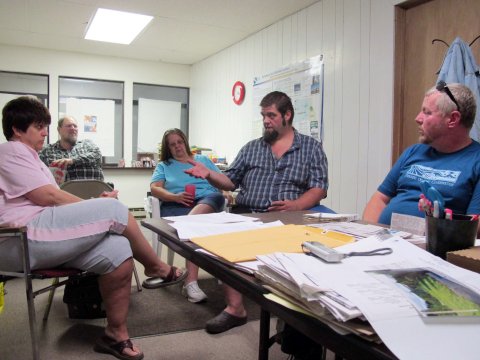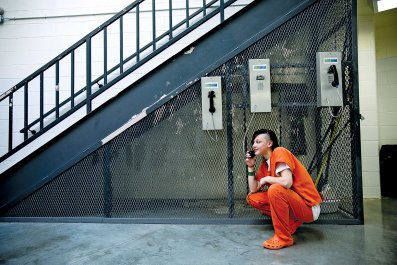Update: This article has been updated and corrected throughout to include additional information provided by the EPA and the Panhandle Health District after initial publication.
"This place stunk so bad," says Paul Flory, "and you had that metal taste in your teeth."
Flory was born in 1970 and grew up in the same part of the country he lives in today: the Coeur d'Alene River Basin of northern Idaho. Beginning in the 1880s and for more than a century, locals have mined this region—also called the Silver Valley—for its abundance of silver, lead and zinc. Some residents can trace their ancestors in the valley back six generations, and "Uncle Bunker"—Bunker Hill, the large mining complex there—was the hand that fed them through all those years.
But it was also slowly poisoning them. As a teenager in Kellogg, Idaho, Flory attended Silver King School, built in 1928 in the gulch between the Bunker Hill lead smelter and zinc plant. An offshoot of the Coeur d'Alene River flowed by the school; it was, says Flory, a "light, glowing green color"—sort of like a glow stick. In 1973, a fire broke out at Bunker Hill and destroyed part of the baghouse—the main pollution-control system for the lead smelter. For the next year and a half, the smelter continued to operate, and dust polluted with heavy metals rained down on the area.
During that time, children living in the area were screened for lead by the state and U.S. Center for Disease Control, and the results were foreboding. Children in Kellogg, for example, averaged 50 micrograms per deciliter of blood; the CDC considers 5 micrograms high enough to warrant concern, and children with levels above 45 micrograms are advised to undergo chelation therapy, which involves administering compounds like dimercaptosuccinic acid, either orally or intravenously, to remove heavy metals from the bloodstream. Lead is a neurotoxin linked to schizophrenia, poor academic performance, low cognitive ability and attention deficit hyperactivity disorder. Once the metal gets into the blood, it concentrates in the brain, kidneys, liver and bones; in pregnant women, lead can cross into the placenta, poisoning their unborn babies.
In 1975, the school board voted to close Flory's school in response to the lead crisis, but parents and residents successfully petitioned to keep it open. So Flory kept going there until sixth grade, in 1982, when the school finally closed after testing undertaken by the local Panhandle Health District showed alarmingly high lead levels in students—Flory included. After three years repeating seventh grade, he dropped out in eighth grade.
By the time he turned 20, Flory was working for one of the local mining companies. His legs hurt constantly, and he suffered from anxiety and mood swings, so he asked his mining company's doctor if lead was to blame. The doctor, he recalls, said no. Now 46 years old, Flory is unemployed, and his adulthood has been scarred by bipolar disorder, ADHD and depression. "Every day, it just makes me sick to my stomach how my life turned out," he says.
Even if Flory hadn't suffered from these mental and physical infirmities, he might still be without work. For decades, Silver Valley's mines were extremely profitable. Then the price of silver sank, and by 1982 they all closed, leaving thousands jobless. Millions of tons of sediment polluted with lead, arsenic, cadmium and zinc remain—in the Coeur d'Alene River, groundwater, lakes, floodplains and hillsides. In 1983, the U.S. Environmental Protection Agency designated a 21-square-mile area of Silver Valley the Bunker Hill Mining and Metallurgical Complex Superfund site. Locals call it "the Box." In 2002, the EPA expanded the site to encompass the entire 1,500-square-mile Coeur d'Alene Basin, recognizing it as among the largest, most polluted places in the nation. But over a decade later, Lake Coeur d'Alene is still filled with lead, wildlife goes to the basin to die, and locals suffer a litany of mental and physical disabilities that make it difficult to get through each day.
Project troubled for years
Russell Kuykendall, 60, was born when the Bunker Hill complex was in full swing. He also attended Silver King School. "You could taste Bunker Hill in your mouth every day," he says, adding that if someone overthrew a ball and it fell into the river near the school, they'd have to grab it quickly before it melted. From the mid-1880s until 1968, companies discharged toxic mine waste tailings directly into the south fork of the Coeur d'Alene River—or "Lead Creek," as the kids nicknamed it.
As an adult, Kuykendall worked in the mines. His son Jimmy, who is 31, avoided the profession, instead doing construction, but he hasn't been able to avoid the poison spread by the mines. Jimmy wears dentures, like his father, because his teeth have rotted out—an affliction of many overexposed to lead. Russell has abdominal pains and trouble concentrating, while Jimmy struggles with violent outbursts. The men say people who live in nearby towns—like those in the affluent tourist hot spot of Coeur d'Alene—consider Kellogg residents crazy. "They call us 'lead heads,'" Jimmy says. Or sometimes "the leaded."
Congress established the Superfund program in 1980 to better catalogue and target places in the U.S. that, because of pollutants and contaminants, are threats to human health. Since then, the government has effectively removed or reduced pollutants and toxins from more than 1,400 sites. These successes include the Rocky Mountain Arsenal in Colorado, a former chemical weapons manufacturing plant that has been turned into one of the largest national wildlife refuges in the country. Another, the Celotex Corporation, a former industrial site in Chicago where asphalt roofing products were produced, is now a green space with athletic fields, basketball courts, a playground and a skate park.

But the Bunker Hill Superfund project has had problems from the start. According to the EPA, in 1990, employees at the agency's Pacific Northwest division went to the EPA's inspector general to complain that their regional administrator was failing to take action against the owners of the Bunker Hill complex; the IG would later accuse the administrator of the agency's Pacific Northwest division of taking "extraordinary steps to prevent formal enforcement actions from being initiated against the owners."1 Meanwhile, the smelter complex deteriorated into a public health hazard, and mining companies—including the Bunker Limited Partnership, which had purchased the complex in 1982 from the Gulf Resources and Chemical Corporation and reopened the Bunker Hill mine in 1988—moved assets to other corporations.2 In 1991, the Bunker Limited Partnership filed for bankruptcy, and no longer had any funds to contribute to the cleanup.3
Over the next decade, the EPA embarked on the first step of the Superfund project—yard cleanups, paid for with funds from two settlements with other mining companies, as well as taxpayer money. The agency conducted free soil testing to identify contaminated spots and hauled it away, replacing it with clean topsoil and sod. About 7,000 residential yards, commercial properties, city parks and school playgrounds have been cleaned up in this fashion. A 2005 National Academies of Sciences report—demanded by Congress and financed with EPA funds earmarked by the legislative branch—found this plan to fix residential areas adequate to protect human health.4 But the authors also expressed concern about the low rate of lead testing in children, advising that all kids 1 to 4 years old in the basin be screened annually. By 2008, the report's testing recommendation still wasn't heeded, says Sue Moodie, who as a master's student at Johns Hopkins University surveyed about 100 Kellogg households. Her follow-up research found that only 3 percent of children on Medicaid in the "the Box" were screened for lead in 2010. These low numbers are, in large part, due to the voluntary nature of the screening program.5 Nevertheless, both the local health district and the EPA were claiming safe lead exposure levels.
In 2012, the EPA released its final plan for the next step of the Superfund project: cleaning up the mines and dumping the toxic material into repositories. Originally, the agency budgeted $1.3 billion and 50 to 90 years for this portion of the cleanup, but, according to the EPA, in the face of strong community opposition, the agency decided to scale it back to $635 million over 30 years.6 The revised plan also cut the number of mines and mills to be cleaned up from 345 to 145.
Many of these mines line the hills within the drainage of the South Fork of the Coeur d'Alene River.7 The river begins high up in the forest. The water flows west, down a steep canyon, to a floodplain and a network of lateral lakes and wetlands. Much of this forest is susceptible to rain-on-snow events, which means rain falls on snow during warmer winters and causes runoff down the mountains destabilized by logging roads and clear-cutting, picking up mining pollution along its journey into Lake Coeur d'Alene.
About 100 million tons of contaminated sediment now cover the floodplain of the Coeur d'Alene Basin.8 "Biologists call these wetlands the 'killing fields' because the mine wastes, especially the lead, kill waterfowl," says Dr. John Osborn, a physician in Spokane, Washington, who founded the Lands Council, which works to preserve and restore forest ecosystems in the Pacific Northwest. "Tundra swans migrating to the Arctic stop over in the Coeur d'Alene River Valley to feed. Many never leave. The lead paralyzes the swans' swallowing mechanism, and they slowly starve to death in a midst of plenty."
In 1996, the Idaho Panhandle experienced a rain-on-snow event that led to major flooding , and rivers climbed to near-record heights. Highways blew out, homes were destroyed, and rockslides followed; the U.S. Geological Survey calculated that more than 1 million pounds of lead rushed into Lake Coeur d'Alene in a single day. Despite this catastrophe, the EPA in 2002 agreed with then–Idaho Governor Dirk Kempthorne that the lake did not warrant Superfund status. Kempthorne went on to serve under President George W. Bush as U.S. Secretary of the Interior—the department that regulates mining.
Another flood in 2011 resulted in an estimated 352,000 pounds of lead washing into the lake in a 24-hour period. Meanwhile, the lake's majestic beauty and mountainous surroundings continue to attract affluent transplants and vacationers. Families come in the summer for weekend getaways, going for swims in the potentially toxic waters of Lake Coeur d'Alene.
In "the Box," even if you stay out of the water and avoid the outdoors, you're still at risk. A 2014 letter from the local health district to a Kellogg resident with the results of an analysis from dust samples collected from the woman's home showed lead concentration measuring 1,590 micrograms. The letter noted that "house dust remains a critical source of exposure to lead and/or arsenic"—a known carcinogen—"for local residents, especially young children," and that lead concentrations in house dust should be less than 500 micrograms.9
'I Can't Get Help'
Progress is being made here. Last summer, the Panhandle Health District tested the lead levels in the blood of 100 children in the Silver Valley.10 In 1983, 25 percent of the valley's children had levels greater than 25 micrograms. In 2015, only six kids had levels above 5 micrograms. And in an effort to ensure the Flint, Michigan, drinking-water crisis doesn't repeat in Idaho, the state Department of Environmental Quality has requested that water utilities re-evaluate their systems for lead levels. Results are expected in July.
But a lot of damage has already been done, and there are very few resources available to victims still in need. Locals require medical care for the various ailments they've developed just by dint of living here for so many years. Sylvia Boe, 78, worked for Bunker Hill mines in the 1970s. "I worked hard," she says, catching her breath. "I bought my own property. I bought my own car. I raised my son myself. I worked like a man, and I got leaded. I got my back hurt. My back still hurts, and they can't do anything about it, and I can't get help. I own nothing. I'm basically homeless." She lists her ailments: a hysterectomy, stroke, nervous breakdowns, hallucinations.
Flory also has a long list of infirmities. In addition to his ADHD and bipolar disorder diagnoses, he has degenerative bone disease—"my left hip is out, and my right shoulder is out"—and high blood pressure. He estimates he's lost dozens of mining jobs because of his health problems. Recently, Flory connected with Barbara Miller, a grassroots activist who runs the Silver Valley Community Resource Center. She would like to see some of the Superfund project's money used to establish a community health clinic where people could access medical evaluations, follow-up monitoring and counseling—but Superfund money can, by law, only be used for cleanup and enforcement actions11 Today, Flory has shifted what limited energy he has to advocating for a clinic or at least, finally, some vindication that chronic lead exposure could be to blame for all the ailments that have plagued him. "Your whole life you feel worthless," he says, "and then you find out why."
***
- Based on discussions with the EPA, this sentence has been amended to note that employees of the agency's Pacific Northwest division asked the inspector general to look into their regional administrator. The EPA also said its staff and Justice Department attorneys were able to successfully pursue enforcement actions against the owners despite the regional administrator's failed efforts.
- EPA placed liens on the BLP and Gulf assets and ultimately recovered approximately $20 million from BLP (85 percent of its assets) and $17 million from Gulf. The money was placed into trust for cleanup actions.
- This sentence has been corrected to note that bankruptcy did not release BLP from their legal obligation to pay for the cleanup.
- This sentence has been amended to note that Congress demanded that the EPA enlist the NAS to undertake this study, and earmarked EPA funds for the project.
- Additional information was added to clarify that low screening levels were largely due to the voluntary nature of the screening program. The EPA said it pays $30 to the family of children who participate in the lead testing program.
- This sentence had been amended to note the reason for the EPA's decision to scale back the cleanup plan.
- This sentence clarifies location of the mines.
- This sentence has been corrected to note that there is currently 100 million tons of contaminated sediment on the floodplain of the Coeur d'Alene Basin, not the Silver Valley, as previously stated. The Silver Valley is part of the Basin.
- The EPA said a limited number of homes periodically exhibit elevated levels of lead and arsenic. Follow up consultations with residents indicate that elevated levels of lead in house dust is frequently due to the tracking in of dirt and dust from recreational activities in areas—like beaches—that have not been cleaned up.
- A previous version of this sentence incorrectly stated that every summer, the local health district tests the blood level of 100 children in the SIlver Valley. In fact, that was the number of 2015.
- This sentence has been amended to highlight the fact that Superfund money cannot, by law, be used to establish public health clinics or programs.




















